Resources & Glossary
A way of managing projects in which work is divided into a series of short tasks, with regular breaks to review the work and adapt the plans (Oxford)
People who are (1) excited about your change and (2) willing to Drive Change, not people
A design choice to design past the laws that require certain accessible features to a playground that exceeds the needs of all children so there are truly no barriers to play
A commitment to frequently notice, define, and celebrate wins related to your change.
The limits of your change, both now and in the future.
A recommendation for action based on experience and resulting in similar situations; a heuristic
I will do what I can, with what I have, where I am.
Building cycles of learning about usability and change obstacles into the product or process design cycles so we can design the product or process for easy use and implementation
A description of a change story using variables to substitute for specific people, changes, and organizations
Explicit, different thoughts, behaviors, or policies that allow the change agents and the change to vary from the status quo people and environment
Changes that continue after the life has gone out of them.
Graph comparing Driving People to Driving Change on an axis of energy to drive the implementation versus distance toward the goal and sustainment
The psychological vestiges of bad past change efforts that manifest as physical and emotional reactions to fresh change
The physical, emotional, and spiritual pain experienced with poorly implemented change
Where all the change falls onto the organization or customers after all the work of readying for it is complete
Change goal summarized into one statement following the pattern:
<Who> will <experience> <what> <where> <when>
Someone forced to join a change against their will
Choosing a change for yourself and clearing the obstacles for others to choose the change too

Using coercion (e.g., orders, fear of negative consequences, removal, or application of positive consequences) to compel others to change

The person or persons you turn to on challenging days to steel your will and give your comfort and strength to continue your change journey.
The protective wing that a leader stretches out to shelter the people who work with them.
When experience with uncontrollable events leads to the expectation that future events will elude control and disruptions in motivation, emotion, and learning may occur (Seligman)
A personal commitment to act on your change regardless of the reaction of the people or environment around it.
When time runs differently inside versus outside the organization
The negative effects of failed changes that people store in their hearts and minds—effects that delay or derail the next change.
A buffer you can create and maintain independent of the organization related to your change.
When an executive only superficially invests in getting the task done versus actually committing to the change
A deliberate change to a policy that permits you and your change to be different from the status quo.
We assume others are much more powerful than they are, and we assume we are much less powerful than we are; the antidote for the Power Paradox is the Change Agent’s Motto.
Something, once created, that may be used many times without the author investing any more time. [example: I invest an hour in a blog post, but it could be read by 1, 10, 100 or 1,000 or more people and I wouldn’t have to invest another minute.]
People who “live on the land” of your change, whose lives you are affecting; settler types include current, missing, past, and downstream
The existing state of affairs (Merriam-Webster) or the cultural library of how things get done here (as defined by John Roberts, my friend and colleague)
The meetings, projects, initiatives and community forums held for already failed changes.
Low-risk transformation where something may be a significant, irreversible change for us, but many people have done it before, and it operates by known mechanisms (our caterpillar is becoming a butterfly, but we aren’t the first caterpillar to become a butterfly)
Path-blazing transformation where what we are attempting is a significant, irreversible change, and we are the first ones to attempt it
Videos
April is the founder of Engine-for-Change LLC and author of Everyone is a Change Agent: A Guide to the Change Agent Essentials and Change Tactics: 50 Ways Change Agents Boldly Escape the Status Quo. She’s consulted for Intel and Delta and has keynoted at events worldwide.
April invests her book proceeds into Gully Crest Homestead, a retreat center she is building in rural Washington state for families with children with special needs. She’s received community awards for expanding community child care and building beyond accessible playgrounds.
April lives in Washington state with her husband, four children, and a menagerie of animals.


